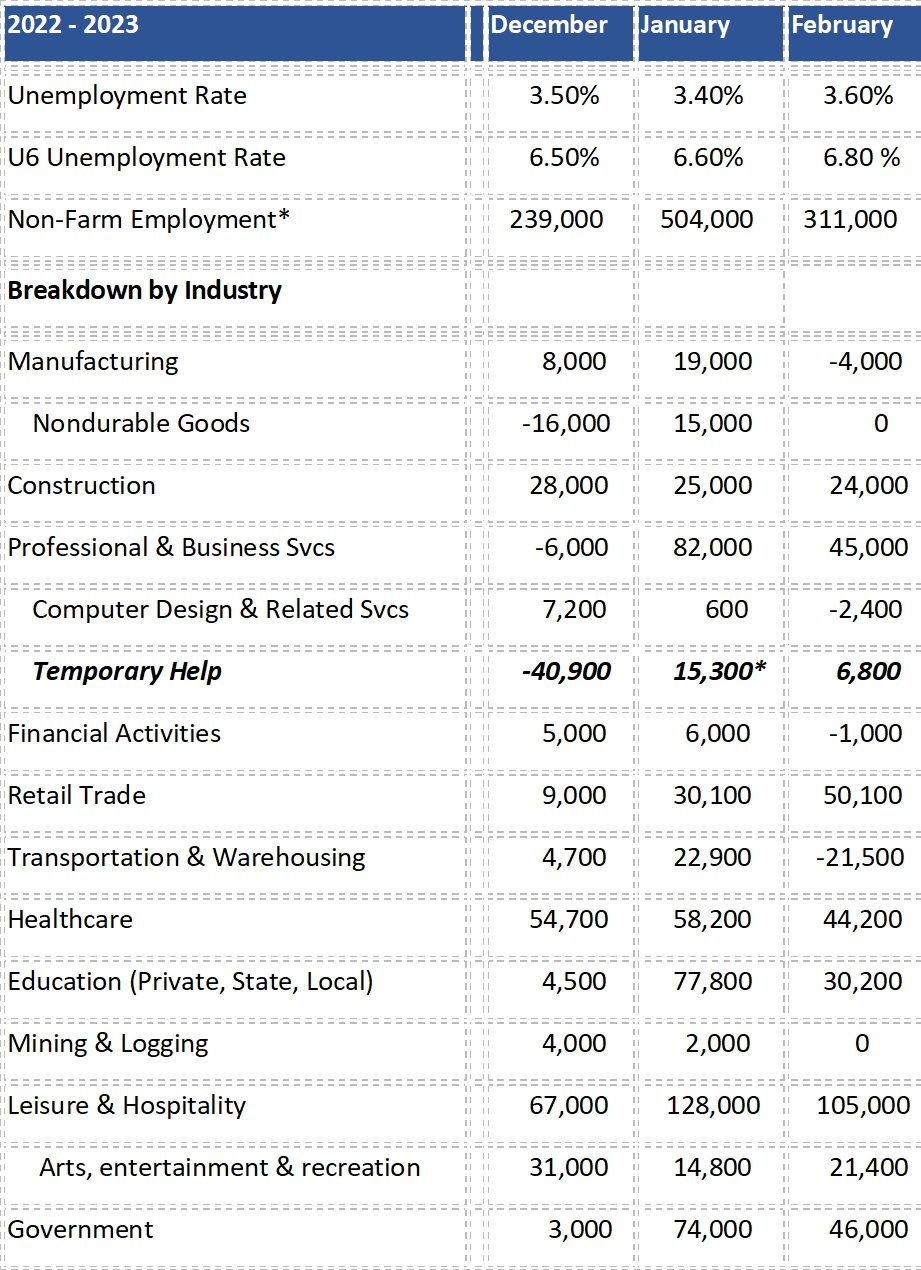Feb 2023 Jobs Summary
- Nick Andriacchi

- Mar 13, 2023
- 4 min read
March comes in like a lion and out like a lamb. I feel that way about the February Jobs Report released 3/10/2023 by the BLS. Top line number continues to roar, but the rest of the report is more sheepish.
What are those signs of more tempered growth?
· The average hour work week was down
· Wage growth continued to slow
· Manufacturing, transportation and warehouse lost jobs
· Job gains were revised DOWN for December and January
· U3 and U6 unemployment rates were both up
· According to the JOLTS report, the number of open jobs decreased in January
I hope the Fed takes notice when they meet about interest rates later in the month.
The big NEWS FLASH here is that prime age labor participation rate (people aged 24 -55) is finally back to the pre-pandemic level of 83.1%. This is fantastic news for employers and should really help to fill open jobs - which will cut down on supply chain issues and help lower inflation long term.
Analysis of the February Employment Report

· Temp Help is up for the second month in row. However, the last months big gain was revised down a bit.
· Nonfarm payrolls increased by 311,000 for the month, above the economists’ estimate.
· Wage growth came in at just .2% last month.
· The JOLTS report estimates that there are 10mm open jobs, down 410,000 from December.
· A more encompassing measure of unemployment (U6) that includes discouraged workers and those holding part-time jobs for economic reasons is up to 6.8%.
· Prime age labor force participation rate (ages 25-54) was up .4% to 83.1%. This is the first time since February 2020 that labor participation among this group was this high, the last month before the pandemic started.
· The overall labor force participation was up .1% 10 62.4%. This number is disappointing as it still sits .8% below the level of February 2020.
· In February, average hourly earnings for all employees on private nonfarm payrolls rose by 8 cents, or 0.2 percent, to $33.09. Over the past 12 months, average hourly earnings have increased by 4.6 percent. In February, average hourly earnings of private-sector production and nonsupervisory employees rose by 13 cents, or 0.5 percent, to $28.42.
· The average workweek for all employees on private nonfarm payrolls edged down by 0.1 hour to 34.5 hours in February. In manufacturing, the average workweek edged down by 0.2 hour to 40.3 hours, and overtime edged down by 0.1 hour to 3.0 hours. The average workweek for production and nonsupervisory employees on private nonfarm payrolls decreased by 0.2 hour to 33.9 hours.
· APD is reported that 242,000 jobs were added in last month.
Source: ADP, BLS, CNBC, Fox News
JOB OPENINGS AND LABOR TURNOVER – January 2023
The number of job openings decreased to 10.8 million on the last business day of January, the U.S. Bureau of Labor Statistics reported today. Over the month, the number of hires and total separations changed little at 6.4 million and 5.9 million, respectively. Within separations, quits (3.9 million) decreased, while layoffs and discharges (1.7 million) increased. This release includes estimates of the number and rate of job openings, hires, and separations for the total nonfarm sector, by industry, and by establishment size class. This release also presents 2022 annual estimates for job openings, hires, and separations.
Job Openings
On the last business day of January, the number and rate of job openings decreased to 10.8 million (-410,000) and 6.5 percent, respectively. In January, the largest decreases in job openings were in construction (-240,000), accommodation and food services (-204,000), and finance and insurance (-100,000). The number of job openings increased in transportation, warehousing, and utilities (+94,000) and in nondurable goods manufacturing (+50,000).
Hires
In January, the number and rate of hires changed little at 6.4 million and 4.1 percent, respectively. Hires changed little in all industries.
Separations
Total separations include quits, layoffs and discharges, and other separations. Quits are generally voluntary separations initiated by the employee. Therefore, the quits rate can serve as a measure of workers’ willingness or ability to leave jobs. Layoffs and discharges are involuntary separations initiated by the employer. Other separations include separations due to retirement, death, disability, and transfers to other locations of the same firm.
In January, the number of total separations changed little at 5.9 million. The rate was unchanged at 3.8 percent. The number of total separations decreased in federal government (-13,000).
In January, the number of quits decreased to 3.9 million (-207,000), and the rate was little changed at 2.5 percent. Quits decreased in professional and business services (-221,000), educational services (-14,000), and federal government (-5,000).
In January, the number of layoffs and discharges increased to 1.7 million (+241,000). The rate was little changed at 1.1 percent. Layoffs and discharges increased in professional and business services (+190,000) but decreased in federal government (-5,000). (See table 5.)
The number of other separations was little changed in January at 302,000. Other separations decreased in professional and business services (-29,000), finance and insurance (-20,000), and health care and social assistance (-18,000). The number of other separations increased in accommodation and food services (+15,000); information (+11,000); and arts, entertainment, and recreation (+4,000).
Establishment Size Class
In January, establishments with 1 to 9 employees saw little change in their job openings rate, hires rate, and total separations rate, but quits rate decreased. Establishments with more than 5,000 employees saw little change in their job openings rate, hires rate, and total separations rate.
____________
The Job Openings and Labor Turnover Survey estimates for February 2023 are scheduled to be released on Tuesday, April 4, 2023, at 10:00 a.m. (ET).



Comments